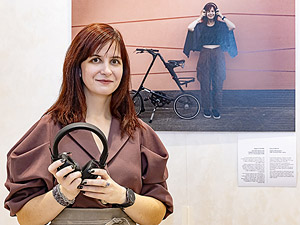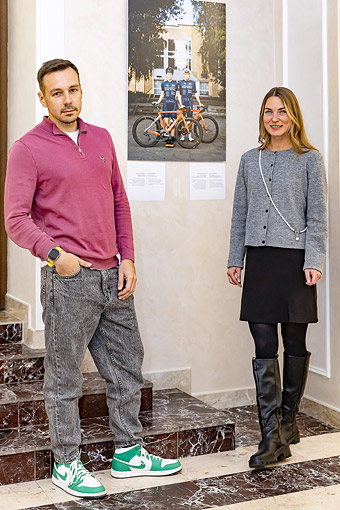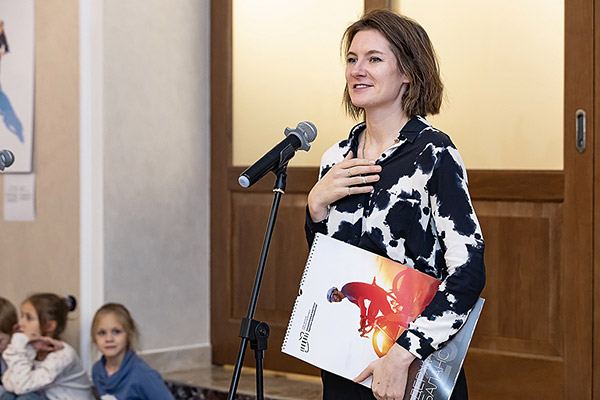
Electronic english version since 2022 |
The newspaper was founded in November 1957
| |
World of hobbies
Photo exhibition "Keep the balance": cycling as a way of life
Currently, the photo project of the JINR Press Office "Keep the balance" is presented at the exhibition hall of the Cultural Centre "Mir". It consists of two parts: the exhibition and the corporate calendar of JINR for 2025 with photographs and quotes from the Institute's employees - beautiful, brave and active cyclists in recognizable places of Dubna. Different ages, genders, nationalities and laboratories are united by a common topic - a bicycle that helps to maintain a life balance, training to maintain tone and clarity of thought, walks and trips for inspiration.
 We talked to the photographer of the project Daria Konova - a JINR employee and an active cyclist. It is curious to learn both about the embodiment of a photo story and about the facets of the profession that are important for shooting photos that attract attention and make one wish to look closely at the details, to find the underlying meanings.
We talked to the photographer of the project Daria Konova - a JINR employee and an active cyclist. It is curious to learn both about the embodiment of a photo story and about the facets of the profession that are important for shooting photos that attract attention and make one wish to look closely at the details, to find the underlying meanings.
Darya, photography has united you with a huge number of different interesting people. Are they the solid foundation of your creative work?
- To some extent, yes. It is interesting and important for me to hear feedback from the people that have been involved in photography or in any other creative work for a very long time. At the same time, I like to photograph people, because each person - it is one's own unique world and own story and it is interesting to reveal it in photography. However, sometimes, I photograph some moments of my life - trips, random shots on the way to work, something that seems interesting to me at work and outside of it. I don't always publish it, often such photos appear "in the drawer".

The photo project "Keep the balance" united some cycling enthusiasts from among the JINR employees. Was there any main common emotion among the heroes of the project?
- I guess so. When we offered the heroes to sit on their bikes and to ride, most of them started smiling. To some extent, a bike helps people to relax and gives them positive emotions.
Analyzing this photo exhibition, do you agree that the camera allows you to capture real emotions and not those that a person wants to show?
- Yes, of course. It is always obvious when a photo is staged and the emotions are not real. You may not immediately notice the pretense during the shoot, but through the camera you can see if the person is smiling through force and is internally tense. Then you need to put the camera aside for a while and talk to the person so that he gets used to the photographer and no longer pays attention to the camera.


Tell me, please, how much time does it take to retouch a photo and do you like the process of analyzing the footage?
- Of course, I like the process of selecting and editing photos. When selecting, you can relive the shooting moments and select only the brightest, most interesting ones. Editing is interesting in its own way. It is especially interesting to edit the color in a photo, because color correction can affect the mood of the photo. In terms of time, everything is different: there are photos that I immediately see how they should look and I do them quite quickly and there are those where I experiment with different color corrections and in the end, I leave the one that seems most suitable to me. Retouching is a difficult task. I usually do light retouching, if it is needed. And it seems to me, it is better to shoot the hero with good light, so that retouching is minimal. After all, a lot depends on the light.

In your opinion, does a photographer need talent or is it mainly technique and skill? Or is it only a balance between a creator and a craftsman?
- It's hard to say. Perhaps, predisposition is important, of course, but more important are skill and observation. You can have some predisposition, but if you do not develop in this area, then there will be no progress in creativity. I would also venture to assume the opposite, that you can attend many different courses, know all the rules of the ideal combination of color, the correct construction of a composition, but if you do not have that predisposition, then the photos will turn out correct, good but not creative. Something will miss in them.
Darya, tell us, please, about your understanding of beauty, how do you define it for yourself?
- Beauty is in the little things, you just have to notice them. Sunlight can fall beautifully on the walls of houses, imprinting the shadows of trees on them. Beauty in life is, for example, people experiencing a different range of emotions. Beauty can be in something imperfect, since there is no ideal.

How have your photos changed since you started taking professional photos?
- Of course, they have. The focus has shifted from what I see to what I want to show and how I see it. I want to convey the mood in the frame, not just to show a pretty picture. If before I could just see the frame and press the shutter button, now, if I see an interesting frame, I think whether I am satisfied with everything in it, or whether I want to "improve" it somehow - to change the angle, to shoot through a prism, others, and only if everything is fine, I take and publish the photo.
It seems that nowadays, it is very important for a person to have some kind of story behind him. What was the key point in the project "Keep the balance"?
- At first, when we were just thinking about the project, we wanted to show the diversity of bicycles and cyclists at JINR first and foremost. And then, people with completely different and interesting stories started responding to us and we ourselves started meeting such people by chance. So, the focus shifted first and foremost to people. Yes, there is a slightly greater diversity of bicycles in Dubna than it is presented in the project. For example, there is a tandem bicycle, it belongs to one of the heroes of the calendar on a BMX bike. Yes, we could have put people on it that would look great on it, but it would be obvious that the photo is staged, the bicycle has nothing to do with the heroes and they see it for the first time and ride it for the first time. Besides, it is much more interesting to photograph people on their own bicycles - they have so many stories about how they chose their bicycles, how they ride them. All this is to ensure that the frame contains genuine emotions and a light, free atmosphere during filming.
If to think about it, what do photographers consider success?
- Different photographers have different opinions, of course. Success is probably being in demand, being invited to participate in projects, when you like the photographer's vision. I am also especially pleased when the people being photographed like themselves in the photographs.
Every photographer has his own vision. What influenced yours?
- A lot of things. Visiting different museums since childhood and looking at paintings by famous artists. In adulthood, getting to know the creative works of photography classics and watching different films, including auteur ones.
If to spend a day with a photographer, what will that day be like? Using the example of working on this project about active cyclists at JINR.
- For example, the day when we were shooting Artem Svintsitsky and his wife Ekaterina on a bike path. Then in the morning, I checked the charge in the batteries in the camera, put them on recharge, checked the free space on the memory card (there was a lot of it then, if there was little, I would have to make sure that the previous shootings were copied to the hard drive and delete them from the memory card). After that - breakfast, then thinking about how to get to the shooting. By the way, we shot almost the entire project while also on bicycles. The shooting then took place on Velo1, it is better to get there not on a triangular folding bike, but on a gravel bike. For speed, it is better to put on cycling shoes to use the contact pedals. Once everything is charged, I put one battery in the camera, I take the second one with me just in case. I choose which lenses I will need so as not to take everything. When everything is collected, I can set off. Then - the actual shooting of the heroes. After the shooting - viewing the selected material and choosing the best photos. I feel more comfortable doing post-processing, when possible, the next day, so that my eyes can rest.
Daria, what do you think, should a creative person have a professional dream and do you have one?
- Since photography is also a hobby for me, it is difficult to say where a creative dream can turn into a professional dream. I would probably really like to constantly make my work diverse and not stagnate in a creative way. And of course, I try to do everything for it.
Until 24 November, we invite everyone to visit the exhibition "Keep the balance" in the Cultural Centre "Mir".
Interviewed by Eleonora YAMALEEVA,
Member of the Union of Theater Workers of the Russian Federation,
photo by Elena PUZYNINA